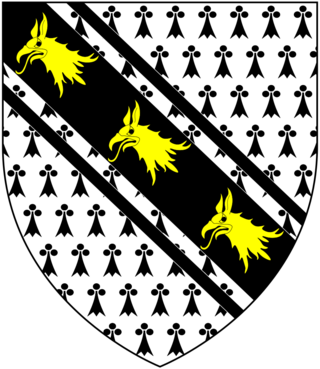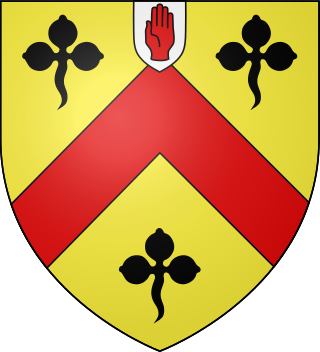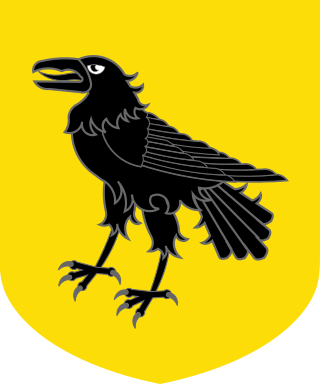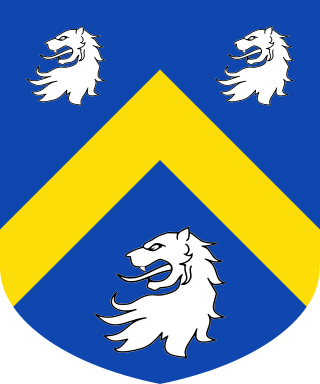
The Bunbury Baronetcy, of Bunbury, Oxon and Stanney Hall in the County of Chester, is a title in the Baronetage of England. It was created on 29 June 1681 for Thomas Bunbury, Sheriff of Cheshire from 1673 to 1674 and the member of an ancient Cheshire family. His grandson, Henry, the third Baronet, and great-grandson, the fourth Baronet, both sat as Members of Parliament for Chester. The latter died unmarried at an early age and was succeeded by his younger brother, the fifth Baronet. He was a clergyman. On his death in 1764 the title passed to his eldest son, the sixth Baronet. He represented Suffolk in the House of Commons for over forty years but is best remembered for his marriage to Lady Sarah Lennox. He died childless in 1821 and was succeeded by his nephew, the seventh Baronet. He was the son of Henry Bunbury, younger son of the fifth Baronet. The seventh Baronet was a distinguished soldier and politician. His eldest son, the eighth Baronet, was High Sheriff of Suffolk in 1868, and Fellow of the Royal Society. He died childless in 1886 and was succeeded by his younger brother, the ninth Baronet. He was Liberal Member of Parliament for Bury St Edmunds. He died unmarried in 1895 and was succeeded by his nephew, the tenth Baronet. He was the son of Colonel Henry William St Pierre Bunbury, third son of the seventh Baronet. He served as High Sheriff of Suffolk in 1908 and was a Deputy Lieutenant of the county. On his death in 1930 the title passed to his son, the eleventh Baronet. He was High Sheriff of Suffolk in 1936 and was a Deputy Lieutenant of the county. His son, the twelfth Baronet, was High Sheriff of Suffolk in 1972. As of 2014 the title was held by the latter's second but eldest surviving son, the thirteenth Baronet, who succeeded in 1985.

Sir Charles Miles Lambert Monck, 6th Baronet was an English politician. He succeeded to the Baronetcy of Belsay Castle on the death of his father in 1795.
This is a list of High Sheriffs of Lincolnshire.
The Langham Baronetcy, of Cottesbrooke in the County of Northampton, is a title in the Baronetage of England. It was created on 7 June 1660 for John Langham, Member of Parliament for the City of London in 1654 and for Southwark in 1660 and 1661. The second Baronet was Member of Parliament for Northamptonshire and Northampton while the third Baronet sat for Northampton. The seventh Baronet was Member of Parliament for Northamptonshire. The tenth Baronet represented St Germans in the House of Commons. The thirteenth Baronet was a photographer, ornithologist and entomologist and served as High Sheriff of County Fermanagh in 1930.

The Baronetcy of Gresley of Drakelow was created in the Baronetage of England on 29 June 1611 for George Gresley of Drakelow Hall, Derbyshire who was later High Sheriff of Derbyshire and Member of Parliament for Newcastle-under-Lyme.

The Yonge Baronetcy, of Culliton in the County of Devon, was a title in the Baronetage of England. It was created on 26 September 1661 for the merchant and Member of Parliament, John Yonge. He was succeeded by his son Walter, the second Baronet. He was also a Member of Parliament. His son, the third Baronet, sat in the House of Commons for more than a quarter of a century. On his death the title passed to his son, the fourth Baronet. He was also a politician and served as Secretary at War. He is also remembered for his diaries. He was succeeded by his son, the fifth Baronet. Like his father he served as Secretary at War and was also Governor of the Cape Colony. The baronetcy became extinct on his death in 1812.
Sir William Williams, 6th Baronet of Faenol (Vaynol) was a Welsh politician and landowner elected as MP for Caernarvonshire from 1689 until his death.
Sir John Tyrwhitt, 5th Baronet, of Stainfield, Lincolnshire, was a British landowner and politician who sat in the House of Commons between 1715 and 1734.

The Palmer Baronetcy, of Carlton in the County of Northampton, was created in the Baronetage of England on 7 June 1660 for the lawyer and politician Geoffrey Palmer. The second Baronet was Member of Parliament for Higham Ferrers. The third, fourth and fifth Baronets all represented Leicestershire in the House of Commons. The fifth Baronet served as High Sheriff of Leicestershire in 1782 and the eighth Baronet as High Sheriff of Northamptonshire in 1871.

The Abdy baronetcy, of Felix Hall, in the County of Essex, was created in the Baronetage of England on 14 July 1641 for Thomas Abdy who was High Sheriff of Essex. The title became extinct in 1868.

The Stapylton baronetcy, or Stapleton, of Myton in Yorkshire, was created in the Baronetage of England on 22 June 1660 for Henry Stapylton.
Sir Samuel Vanacker Sambrooke, 3rd Baronet of Bush Hill, Enfield, Middlesex, was a British landowner and politician who sat in the House of Commons as MP for Bramber and Great Bedwyn.

The Cholmeley baronetcy, of Easton in the County of Lincoln, was created in the Baronetage of the United Kingdom on 4 March 1806 for Montague Cholmeley, subsequently Member of Parliament for Grantham. His son, the second Baronet, sat as Member of Parliament for North Lincolnshire. He was succeeded by his son, the third Baronet, who also represented Grantham as MP. His grandson, the fifth Baronet, was High Sheriff of Lincolnshire in 1961 and a Vice-Lord-Lieutenant and Deputy Lieutenant of the county.

The Corbet baronetcy, of Stoke upon Tern in the County of Shropshire, was created in the Baronetage of England on 19 September 1627 for John Corbet.

The Corbet baronetcy, of Moreton Corbet in the County of Shropshire, was created in the Baronetage of England on 29 January 1642 for the Royalist Vincent Corbet. Both he and the second Baronet sat as Members of Parliament for Shropshire.

The Kaye baronetcy, of Woodesham in the County of York, was created in the Baronetage of England on 4 February 1642 for John Kaye of Woodsome Hall, Almondbury, Yorkshire. He was a colonel of the Horse in the service of King Charles I during the Civil War. His title was forfeit under the Parliamentarian rule, but was restored after the return of the monarchy in 1660.

The Owen baronetcy, of Orielton in the County of Pembroke, was created in the Baronetage of England on 11 August 1641 for Hugh Owen, Member of Parliament for Pembroke, Haverfordwest and Pembrokeshire.

The Dudley baronetcy, of Clopton in the County of Northampton, was created in the Baronetage of England on 1 August 1660 for William Dudley. He was High Sheriff of Northamptonshire that year, and was briefly Member of Parliament for Northampton in 1663. The 2nd Baronet represented both Northampton and Huntingdonshire in Parliament.

The Dalrymple baronetcy of Hailes, Midlothian was created in the Baronetage of Nova Scotia on 8 May 1701, for David Dalrymple, fifth son of James Dalrymple, 1st Viscount of Stair. He was Member of Parliament for Haddington Burghs from 1708 to 1721, in the Parliament of Great Britain. This title became extinct on the death of the 5th baronet, Sir John, on 17 October 1829.

The Preston baronetcy, of Valleyfield in the County of Perth, was created in the Baronetage of Nova Scotia on 13 March 1637 for George Preston, the son of Sir John Preston and his wife Grizel Colville. The baronetcy came with a grant of 16,000 acres (6,500 ha) in Nova Scotia.














